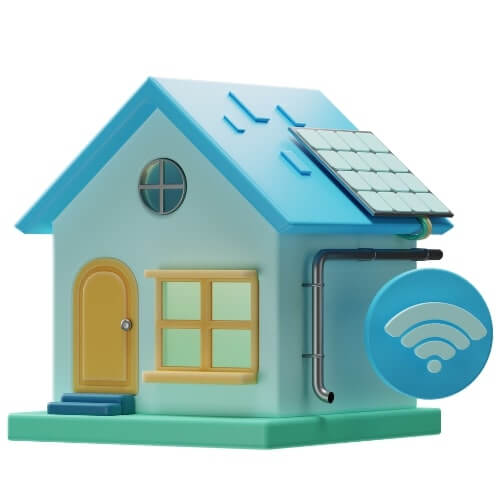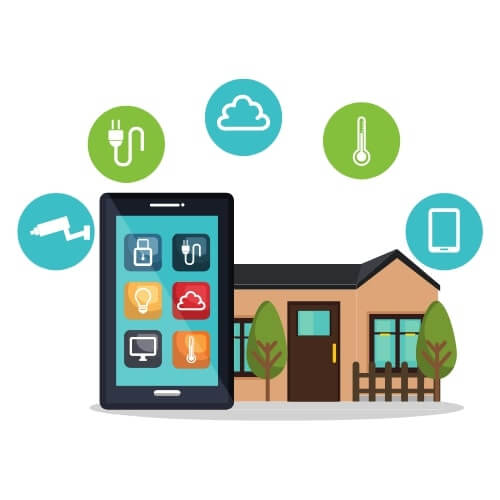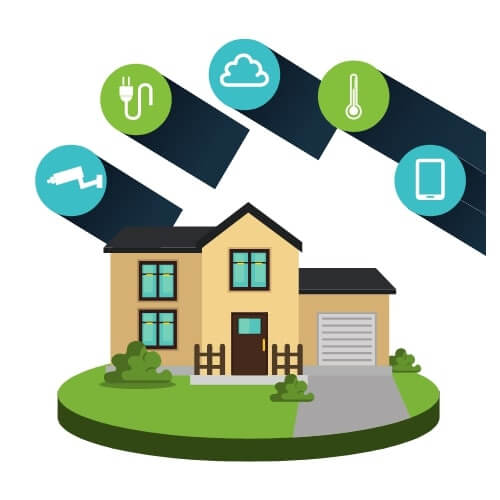Smart homes are becoming increasingly popular as they provide homeowners with convenience and control over their environment. To understand the terminology associated with smart home automation technology, it’s important to be familiar with some of the key terms used in this field.
Here is a comprehensive A-Z smart home glossary automation terms:
SMART HOME GLOSSARY
A
Automation – The process of using technology to automate mundane tasks such as turning on lights or locking doors.
Alexa – An Amazon virtual assistant which can control various devices in the home.
Away Mode – A feature that allows a user to easily set multiple devices in the home to an “away” mode for added security.
AIO (All-in-One) – A type of device that combines multiple functions, such as lighting and home security, into one system.

B
Bluetooth – A wireless technology that allows devices to connect and exchange data over short distances. It is commonly used in smart home automation systems to control lighting, thermostats, security cameras, and more.
Bridge – A device that connects two networks with different communication protocols. Bridges are useful in a smart home setup where multiple devices with different communication protocols need to be connected.
Burglar Alarms – A device intended to detect and deter intruders.
Biometric Safes – A type of safe that is opened with a fingerprint, retinal scan, or other biometric authentication.
C
Climate Control – A feature that allows a user to set the temperature and other conditions in their quarters for maximum comfort.
Connected Home Platform – Software that allows multiple devices within a home to communicate with one another, automate tasks, and provide access to the remote control.
Connected Home Hub – A central device that can be used to control and communicate with other connected devices in the home.
Central Hub – A central controller or bridge used to manage all of the connected devices at once.
Cloud Computing -A type of computing where data is stored and processed on remote servers rather than on local computers or devices.
D
Data Logging – The process of capturing and storing data from sensors and other devices to be used later for analysis or automation purposes.
Device Control – The ability to control multiple devices within a smart home system, such as lights, thermostats, security cameras, and more.
Digital Assistant – A virtual assistant that can be used to control various devices in the home. Popular digital assistants include Amazon’s Alexa and Google Home.
Door locks – Smart locks which can be remotely opened and closed using an app or other connected device.
E

Energy Management – A feature that allows a user to monitor their energy usage and set thresholds for when certain appliances should turn off or on.
Electric Vehicle Charger – Smart electric vehicle chargers allow you to charge your EV efficiently and conveniently, with the ability to set charging times and monitor energy usage.
Energy Monitor – A device that tracks real-time energy consumption in order to help homeowners manage their electricity costs more effectively.
Energy Storage System – An intelligent system designed to store energy for later use.
F
Facial Recognition – A technology that uses facial recognition algorithms to identify people. It is commonly used in smart home security systems to identify homeowners or guests and grant access accordingly.
Firmware Updates – Software updates that are applied to connected devices within a smart home system. Firmware updates can enhance the performance, security, and features of these devices.
G
Gateway – A device that allows users to connect their local network to the internet, allowing for remote access and control of their connected devices.
Geofencing – A location-based feature that restricts access to a home based on the user’s current location.
H
Home Automation – The process of using technology to automate mundane tasks such as turning on lights or locking doors.
Home Security System – A system designed to protect a home from intruders and other security threats. It typically includes features such as motion sensors, video cameras, and alarms.
Home Entertainment System – A system that allows users to integrate audio, video, and other media within a smart home environment.
I
Internet of Things (IoT) – A network of connected devices that can be controlled remotely via the Internet.
Infrared Technology – A technology that uses invisible infrared light to send signals between two points. It is commonly used in remote control systems for TVs or other electronics.
J
Journals – A feature that records all of a homeowner’s activities, such as what doors were opened or when lights were turned on/off. This information can be used for analyzing energy usage and creating automated routines.
Just-In-Time Automation – A type of automation that allows for tasks to be completed only when needed, such as unlocking a door when someone arrives at the house or
K
Keyless Entry – A security system that allows users to unlock their doors without the use of a physical key.
Kiosks – Touchscreen kiosks that can be used to control smart home devices, view energy usage data or access other information.
L
Lighting Control – The ability to control the lighting in your home with your smartphone or other devices. This can include dimming lights, setting light scenes, and scheduling when lights should turn on and off.
Local Storage – The ability to store data on local devices instead of relying on an internet connection. This can be used to create backup copies of data or provide a secure way to store sensitive information.

M
Motion Sensors – A type of sensor that can detect movement and be used to trigger events such as turning on lights or sounding an alarm.
Mobile App – An app that allows users to control their smart home devices from their smartphone or tablet.
N
Network Security – Systems designed to protect connected devices within a smart home system from malicious actors or threats.
NFC (Near Field Communication) – A technology that allows two devices to communicate over a short distance without an internet connection. It is commonly used in contactless payment systems and keyless door locks.
O
Occupancy Sensors – A type of sensor that can detect when someone is in the room and be used to control lights, HVAC systems, and other devices.
Omni-directional Speakers – A type of speaker that can project sound in all directions. It is commonly used in smart home systems to create an immersive audio experience.
P
Power Metering – A feature that allows a user to track their energy usage and set thresholds for when certain appliances should turn off or on.
Personal Assistants – Smart assistants such as Amazon Alexa and Google Home that allow users to control their smart home devices using voice commands.
Power Management System – A system designed to automate and optimize the power usage of a home or business. It can help save energy by turning off lights, HVAC systems, and other devices when not in use.
Q
Quality of Service (QoS) – A feature that prioritizes network traffic based on specific criteria, helping to ensure that all the connected devices in the smart home system have the best possible performance.
Queue-Based System – A type of automation system that allows users to create queues of tasks that will be performed in order. This can be used to automate routine tasks such as turning on lights and setting the thermostat at specific times.
R
Remote Access – The ability for users to control their smart home from anywhere with an internet connection. This is commonly done through a smartphone app or web interface.
Robotics – A type of automation technology that utilizes robots to automate tasks or provide assistance. This can include robotic vacuums, window cleaners, lawnmowers, and more.
S

Smart Home Hub – A centralized device that connects all of your smart home devices and allows you to control them with a single app or remote.
Smart Plugs – Small plugs that can be used to control electrical appliances with your smartphone or other devices.
Smart Appliances – Appliances such as refrigerators, ovens, and washers/dryers that are connected to the internet and can be controlled remotely.
Sensor Networks – A network of sensors designed to collect data from the environment, such as temperature, humidity and motion. This data can be used to trigger automated events or send notifications.
Security Cameras – Cameras that are connected to the internet and can be used to monitor a home or business remotely.
Smoke Detectors – A type of sensor that can detect smoke and be used to trigger alarms or send notifications.
T
Temperature Control – The ability to adjust the temperature in a home remotely via a smartphone or other device.
Tagging – The ability to assign labels or “tags” to items in a home, such as furniture and appliances. This can be used to easily identify specific items in the home for automated tasks or notifications.
Thermostat – A device that can be used to control the heating and cooling in a home by adjusting the temperature setting. It can be controlled remotely via a smartphone or other device.
Time Scheduling – The ability to set specific times for automated tasks, such as turning on lights or sounding an alarm.
U
User Profiles – A feature that allows users to create customized profiles that can be used to automate certain tasks based on their preferences.
UPS (Uninterruptible Power Supply) – A device designed to provide power to a system in the event of a power outage. It is often used as part of a backup power system for smart homes.
V
Voice Control – The ability to control connected devices with your voice.
Voice Activation – The ability to control devices using voice commands. Smart home systems typically use voice-activated personal assistants such as Amazon Alexa or Google Home.
Voice Recognition – The ability of a device to recognize and respond to voice commands. This is commonly used by virtual assistants such as Amazon Alexa and Google Home.
W
Wireless Networking – A method of connecting devices together over a wireless network, such as Wi-Fi or Bluetooth.
Wireless Protocols – Standards for communication between wireless devices, such as Wi-Fi, Zigbee and Z-Wave.
X
X10 Protocol – A communication protocol that is used in home automation products and allows for two-way communication between them.
Y
Yale Lock – A type of lock that is compatible with a variety of smart home systems and can be unlocked remotely.
Z
Zone-Based Automation – A type of automation that allows users to create different “zones” within their home, such as a bedroom or living room, and control devices within those zones with a single command.
Z-Wave – A wireless protocol designed specifically for smart home systems. It is used to connect compatible devices, such as lights, locks, thermostats and more.
ZigBee – Another wireless protocol designed specifically for smart home systems that can be used to connect compatible devices.
The list of technologies and features that are integrated into the modern smart home is ever-evolving. From motion sensors and video cameras to alarms and voice control, today’s connected homes offer unprecedented convenience, security, and comfort.
As new products become available, homeowners can use the latest advancements to make their homes even smarter. With the ongoing development of technology, the possibilities for smart home solutions are limitless.

